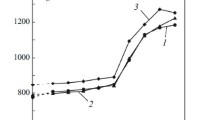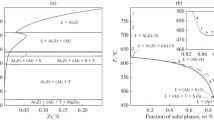Conclusions
-
1.
Molybdenum hardens the solid solution after quenching and the higher the concentration of molybdenum the harder the solid solution.
-
2.
After prolonged aging (up to 20 h at 680°C) the hardness increases, with simultaneous decrease in microhardness, which is due to the precipitation of intermetallic compounds of nickel and molybdenum.
-
3.
A relatively short aging period (up to 4 h) does not change the lattice constant or the specific electrical resistance, which indicates that no changes occur in the alloyed solid solution.
-
4.
The change in hardness after a short period of aging is probably the results of intragranular processesredistribution of alloyed elements and possibly a change in the dislocation density.
Similar content being viewed by others
Author information
Authors and Affiliations
Additional information
Translated from Metallovedenie i Termicheskaya Obrabotka Metallov, No. 1, pp. 19–21, January, 1966
Rights and permissions
About this article
Cite this article
Kontorovich, I.E., Voshedchenko, B.M. & Buntushkin, V.P. Influence of molybdenum on the properties of Kh15N85 alloy. Met Sci Heat Treat 8, 21–23 (1966). https://doi.org/10.1007/BF00660157
Issue Date:
DOI: https://doi.org/10.1007/BF00660157




